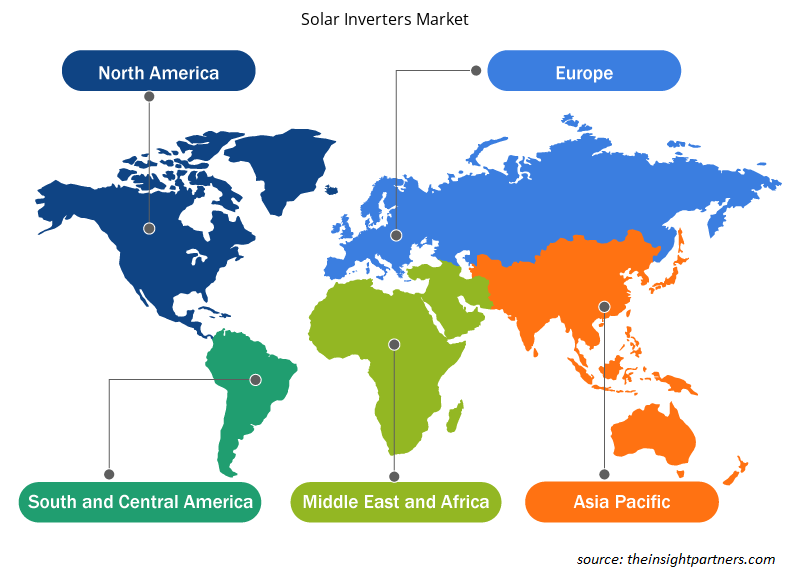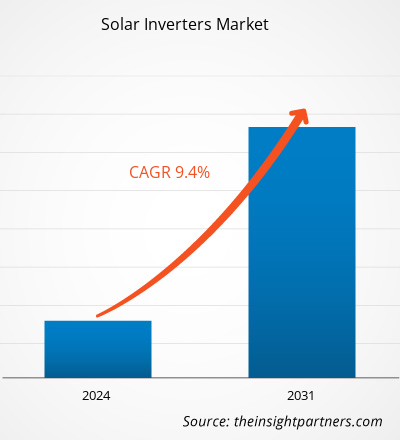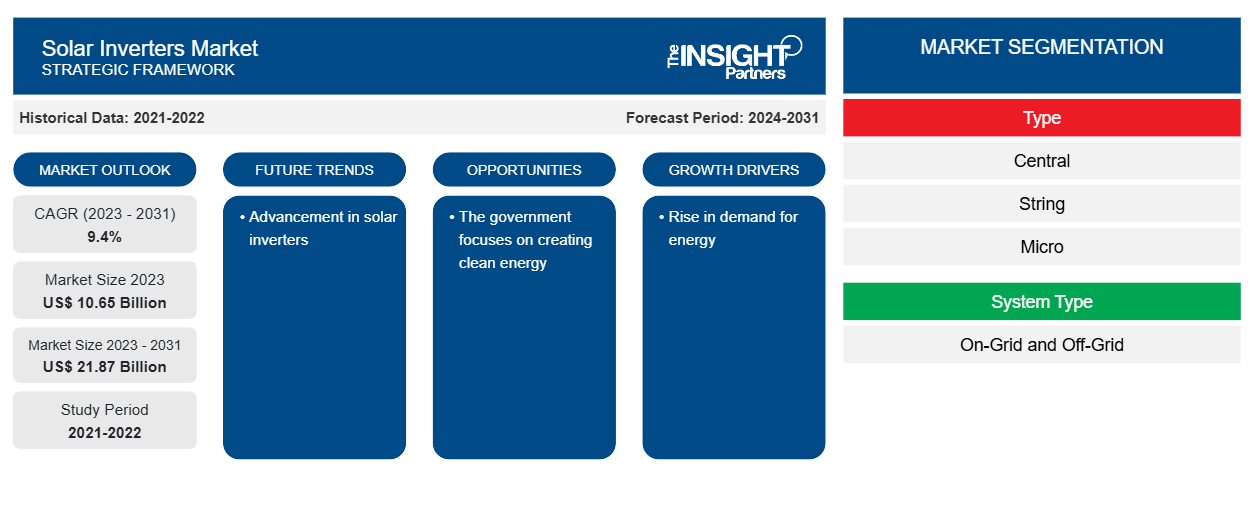Der Markt für Solarwechselrichter soll von 10,65 Milliarden US-Dollar im Jahr 2023 auf 21,87 Milliarden US-Dollar im Jahr 2031 anwachsen. Der Markt soll zwischen 2023 und 2031 eine durchschnittliche jährliche Wachstumsrate von 9,4 % verzeichnen. Der wachsende Bedarf an sauberen Energielösungen und die zunehmenden staatlichen Initiativen zur Installation von Solarwechselrichtern dürften weiterhin wichtige Trends auf dem Markt bleiben.
Solar-Wechselrichter-Marktanalyse
Der Anstieg der Investitionen in Solarenergie ist einer der Hauptfaktoren, die den Markt für Solarwechselrichter ankurbeln. So kündigte das US-Innenministerium im April 2024 eine Investition von 19 Millionen US-Dollar aus Präsident Bidens „Investing in America“-Agenda an, um Solarmodule über Bewässerungskanälen in Kalifornien, Oregon und Utah zu installieren und so gleichzeitig die Verdunstung kritischer Wasservorräte zu verringern und die Ziele für saubere Energie voranzutreiben. Darüber hinaus treibt die zunehmende Installation von Solartechnologie auf Dächern im Wohnsektor das Marktwachstum an. Die staatlichen Subventionen für die Installation von Solartechnologie fördern das Wachstum des Marktes für Solarwechselrichter zusätzlich.
Marktübersicht für Solarwechselrichter
Ein Solarwechselrichter, auch Photovoltaik-Wechselrichter genannt
(
Ein PV-Wechselrichter ist ein Wechselrichtertyp, der Energie aus Sonnenlicht bezieht. Er wandelt den variablen Photovoltaik-Gleichstrom in Wechselstrom um, der die Energie in das kommerzielle Stromnetz einspeist oder von einem lokalen, netzunabhängigen Stromnetz genutzt wird. Der Bedarf an sauberer Energie wächst weltweit, um die negativen Auswirkungen auf die Umwelt zu verringern. Dieser Faktor fördert die Nachfrage nach Solarenergie, was den Markt für Solarwechselrichter weiter ankurbelt.
Passen Sie diesen Bericht Ihren Anforderungen an
Sie erhalten kostenlos individuelle Anpassungen an jedem Bericht, einschließlich Teilen dieses Berichts oder einer Analyse auf Länderebene, eines Excel-Datenpakets sowie tolle Angebote und Rabatte für Start-ups und Universitäten.
-
Holen Sie sich die wichtigsten Markttrends aus diesem Bericht.Dieses KOSTENLOSE Beispiel umfasst eine Datenanalyse von Markttrends bis hin zu Schätzungen und Prognosen.
Regionale Einblicke in den Markt für Solarwechselrichter
Die regionalen Trends und Faktoren, die den Markt für Solarwechselrichter im Prognosezeitraum beeinflussen, wurden von den Analysten von Insight Partners ausführlich erläutert. In diesem Abschnitt werden auch die Marktsegmente und die Geografie für Solarwechselrichter in Nordamerika, Europa, im asiatisch-pazifischen Raum, im Nahen Osten und Afrika sowie in Süd- und Mittelamerika erörtert.

- Holen Sie sich die regionalen Daten für den Solarwechselrichtermarkt
Umfang des Marktberichts zu Solarwechselrichtern
| Berichtsattribut | Details |
|---|---|
| Marktgröße im Jahr 2023 | 10,65 Milliarden US-Dollar |
| Marktgröße bis 2031 | 21,87 Milliarden US-Dollar |
| Globale CAGR (2023 - 2031) | 9,4 % |
| Historische Daten | 2021-2022 |
| Prognosezeitraum | 2024–2031 |
| Abgedeckte Segmente |
Nach Typ
|
| Abgedeckte Regionen und Länder |
Nordamerika
|
| Marktführer und wichtige Unternehmensprofile |
|
Marktteilnehmerdichte: Der Einfluss auf die Geschäftsdynamik
Der Markt für Solarwechselrichter wächst rasant, angetrieben durch die steigende Nachfrage der Endnutzer aufgrund von Faktoren wie sich entwickelnden Verbraucherpräferenzen, technologischen Fortschritten und einem größeren Bewusstsein für die Vorteile des Produkts. Mit steigender Nachfrage erweitern Unternehmen ihr Angebot, entwickeln Innovationen, um die Bedürfnisse der Verbraucher zu erfüllen, und nutzen neue Trends, was das Marktwachstum weiter ankurbelt.
Die Marktteilnehmerdichte bezieht sich auf die Verteilung der Firmen oder Unternehmen, die in einem bestimmten Markt oder einer bestimmten Branche tätig sind. Sie gibt an, wie viele Wettbewerber (Marktteilnehmer) in einem bestimmten Marktraum im Verhältnis zu seiner Größe oder seinem gesamten Marktwert präsent sind.
Die wichtigsten auf dem Markt für Solarwechselrichter tätigen Unternehmen sind:
- FIMER SpA.
- Delta Electronics, Inc.
- Enertechups
- GUTWE
- Leistungselektronik SL
- Powerone Micro Systems Pvt. GmbH
Haftungsausschluss : Die oben aufgeführten Unternehmen sind nicht in einer bestimmten Reihenfolge aufgeführt.

- Überblick über die wichtigsten Akteure auf dem Solarwechselrichtermarkt
Neuigkeiten und aktuelle Entwicklungen zum Solarwechselrichtermarkt
Der Markt für Solarwechselrichter wird durch die Erhebung qualitativer und quantitativer Daten aus Primär- und Sekundärforschung bewertet, die wichtige Unternehmensveröffentlichungen, Verbandsdaten und Datenbanken umfasst. Nachfolgend sind einige der Entwicklungen auf dem Markt für Solarwechselrichter aufgeführt:
- INVTSolar hat auf dem SolarQuarter State Business Meet 2023 in Indien erfolgreich das neueste Produkt, den On-Grid-Wechselrichter XG1-5kW-S, vorgestellt. INVTSolar gewann die Auszeichnung „State Leadership Awards 2023 – Gujarat“, die seine tiefgreifende technische Kompetenz, seine starke F&E-Stärke und seine herausragenden Leistungen unter Beweis stellte – der einphasige On-Grid-Solarwechselrichter XG1-5KTL-S. (Quelle: NTT Ltd, Pressemitteilung, Dezember 2023)
- Colt Data Centre Services (DCS), ein globaler Anbieter von Hyperscale- und Großunternehmens-Rechenzentrumslösungen, gab die Eröffnung seines ersten Rechenzentrums in Indien bekannt. Das Flaggschiff-Rechenzentrum in Navi Mumbai markiert die strategische Expansion von Colt DCS und sein Engagement, die steigende Nachfrage von Hyperscale-Cloud-Dienstanbietern und Großunternehmen auf dem schnell wachsenden indischen Rechenzentrumsmarkt zu unterstützen. Das Rechenzentrum verfügt vor Ort über ein hochbelastbares 220-kV-GIS-Umspannwerk mit LILO-Konfiguration. (Quelle: Colt Data Centre Services Holdings, Pressemitteilung, September 2023)
Marktbericht zu Solarwechselrichtern – Umfang und Ergebnisse
Der Bericht „Marktgröße und Prognose für Solarwechselrichter (2021–2031)“ bietet eine detaillierte Analyse des Marktes, die die folgenden Bereiche abdeckt:
- Marktgröße und Prognose für Solarwechselrichter auf globaler, regionaler und Länderebene für alle wichtigen Marktsegmente, die im Rahmen des Projekts abgedeckt sind
- Markttrends für Solarwechselrichter sowie Marktdynamik wie Treiber, Einschränkungen und wichtige Chancen
- Detaillierte PEST/Porters Five Forces- und SWOT-Analyse
- Marktanalyse für Solarwechselrichter mit wichtigen Markttrends, globalen und regionalen Rahmenbedingungen, wichtigen Akteuren, Vorschriften und aktuellen Marktentwicklungen
- Branchenlandschaft und Wettbewerbsanalyse, die die Marktkonzentration, Heatmap-Analyse, prominente Akteure und aktuelle Entwicklungen auf dem Markt für Solarwechselrichter umfasst
- Detaillierte Firmenprofile
- Historische Analyse (2 Jahre), Basisjahr, Prognose (7 Jahre) mit CAGR
- PEST- und SWOT-Analyse
- Marktgröße Wert/Volumen – Global, Regional, Land
- Branchen- und Wettbewerbslandschaft
- Excel-Datensatz
Aktuelle Berichte
Verwandte Berichte
Erfahrungsberichte
Grund zum Kauf
- Fundierte Entscheidungsfindung
- Marktdynamik verstehen
- Wettbewerbsanalyse
- Kundeneinblicke
- Marktprognosen
- Risikominimierung
- Strategische Planung
- Investitionsbegründung
- Identifizierung neuer Märkte
- Verbesserung von Marketingstrategien
- Steigerung der Betriebseffizienz
- Anpassung an regulatorische Trends























 Kostenlose Probe anfordern für - Markt für Solarwechselrichter
Kostenlose Probe anfordern für - Markt für Solarwechselrichter